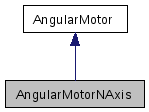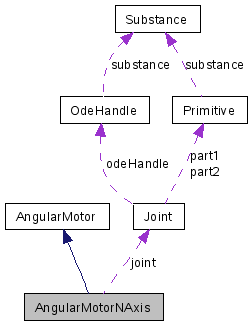
#include <angularmotor.h>
Inherits AngularMotor.
Inheritance diagram for AngularMotorNAxis:


Public Member Functions | |
| AngularMotorNAxis (const OdeHandle &odeHandle, Joint *joint, std::list< std::pair< double, Axis > > axis) | |
| Constuct a motor attached to any Joint (not Sliders!). | |
| virtual | ~AngularMotorNAxis () |
| virtual int | getNumberOfAxes () |
| returns the number of Axis of this Motor | |
| virtual void | set (int axisNumber, double velocity) |
| sets the desired speed of the motor at the given axis. | |
| virtual double | get (int axisNumber) |
| returns the speed (PositionRate) at the given axis, or zero if the axis is out of range | |
| virtual void | setPower (double power) |
| sets the maximal force the motor has | |
| virtual Joint * | getJoint () |
| returns the joint to which this motor is attached | |
Protected Attributes | |
| Joint * | joint |
| AngularMotorNAxis | ( | const OdeHandle & | odeHandle, | |
| Joint * | joint, | |||
| std::list< std::pair< double, Axis > > | axis | |||
| ) |
Constuct a motor attached to any Joint (not Sliders!).
The axis have to be provided by the user.
| axis | list of axis vector and power If empty then it motor is disabled. Power is the maximum force or torque that the motor will use to achieve the desired velocity. This must always be greater than or equal to zero. Setting this to zero (the default value) turns off the motor. |
| virtual ~AngularMotorNAxis | ( | ) | [inline, virtual] |
| double get | ( | int | axisNumber | ) | [virtual] |
returns the speed (PositionRate) at the given axis, or zero if the axis is out of range
So we return the last set position!.
Implements AngularMotor.
| virtual Joint* getJoint | ( | ) | [inline, virtual] |
| int getNumberOfAxes | ( | ) | [virtual] |
| void set | ( | int | axisNumber, | |
| double | velocity | |||
| ) | [virtual] |
sets the desired speed of the motor at the given axis.
| velocity | Desired motor velocity (this will be an angular or linear velocity). |
Implements AngularMotor.
| void setPower | ( | double | power | ) | [virtual] |
 1.4.7
1.4.7